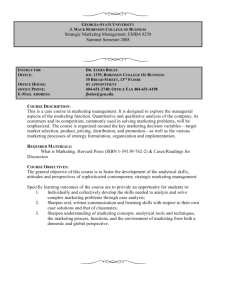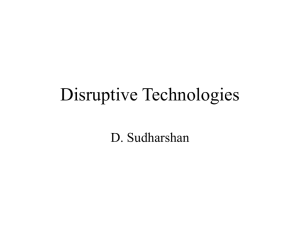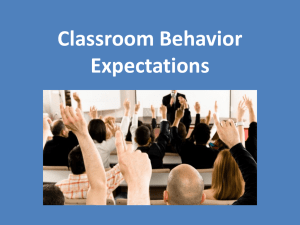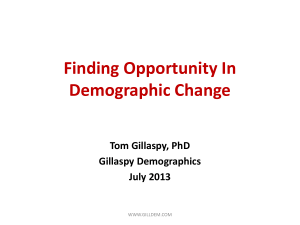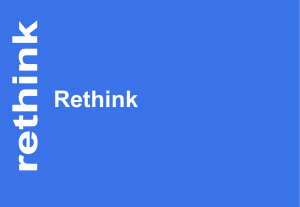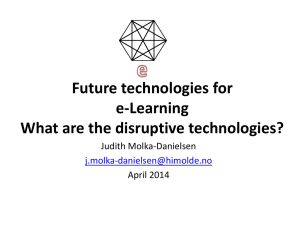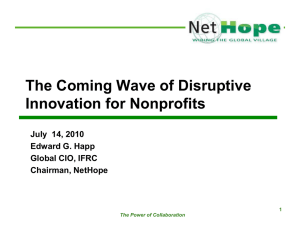Behavioral Economics and Disruptive Innovation in Consumer
advertisement
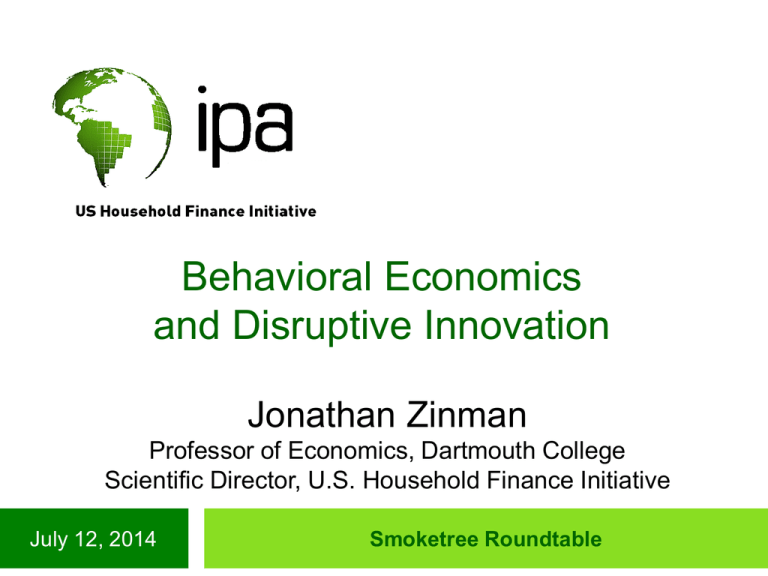
Behavioral Economics and Disruptive Innovation Jonathan Zinman Professor of Economics, Dartmouth College Scientific Director, U.S. Household Finance Initiative July 12, 2014 Smoketree Roundtable What is Behavioral Economics (BE)? • At its best it melds: – Psychologist’s rich understanding of decision making (complexity, biases, and fallability) – Economist’s rich understanding of markets • At its worst… – Rejects homo economicus without offering constructive alternative • “People are irrational”… how/when/where/why? • “Context matters?”… how/when/where/why? – Used to justify prescriptions that far outstrip evidence How is BE being applied in consumer finance? • Communications – Marketing – Reminders – Feedback • Pricing • Process – “on-ramping” – Default options (opt-out 401k’s) • Product development – SMaRT – (Harder savings commitments) – (Spending controls) Long history of BE-like applications for ill A few examples: • “Monthly payments” marketing • Teaser pricing • Rebates • Bundling add-ons • Etc. Can BE be harnessed to improve outcomes? • Probably, but the jury is still out • Mounting evidence on how to apply BE for behavior change • Much less evidence on if/when behavior change actually makes people better off Outcomes-based measurement: Which outcomes? Personal Balance Sheet Assets Liabilities Deposit Accounts $6,102 First Mortgage CDs $3,783 Second Mortgage Stocks $4,983 Vehicle Loans $5,242 Bonds $4,534 Credit Cards $6,503 Mutual Funds $3,549 Student Loans IRAs $15,004 Margin Loans $0 401(k) $32,765 Payday Loans $0 Automobiles $12,186 Other Installment Debt Real Estate Other Property Total Assets $220,800 Other Lines of Credit $170,400 $18,300 $12,987 $3,210 $0 $14,222 $317,928 Total Liabilities $216,642 Net Worth $101,286 Can BE be harnessed for good, in a game-changing way? • I’m optimistic • Will illustrate with 4 high-level ideas – 2 for policy and 2 practice BE-informed disruptive innovation: Information policy Old approach: point-of-sale disclosure BE-approach: – Rethink timing: decision point of pre-POS – Rethink content (amount, density, framing, etc.) • Including meta-information (build “wariness”) • Including the possibility of persuasive content – Rethink channels – Rethink sender Examples: CFPB Office of Engagement, Smart Disclosure, ?? BE-informed disruptive innovation: Principles-based regulation BE opens possibility that some products/transactions harmful even if not deceptive, fraudulent per se. But… how define and measure harm? Are we moving toward a regulatory environment where it will make sense for more firms to turn “compliance” on its head? BE and disruptive innovation: BE as a discipline Methods for applying BE: 1. Assume you know enough to write RXs – Many cautionary tales here 2. Throw out a bunch of stuff and see what sticks (a lot of AB testing uses this approach) *3. Use BE to innovate more efficiently – What to test? – What do test results tell us about promising approaches to future innovations? • Subsequent rounds of testing • In other functions/units of the business BE and disruptive innovation: BE -> new products, industries? Example: “Liability Management” Consumer pain points (high-level): • How do I find the best loan for me? – Many overpay, a lot • Whom can I trust to help me? – Advice market fragmented, lots of low-quality providers Business case premise: • Huge asset management industry • But debt is where the money is for most consumers – Hundreds of basis points on trillion of dollars Bottleneck: “consumers won’t pay” • BE helps us see this is, very likely, utter nonsense From BE to a new business model “People won’t pay out-of-pocket for value-added financial services…” But: People do pay for credit report management, identity protection, tax prep, etc. People will pay when they are liquid (tipping the teller at the check-cashing window; tax-refund frenzy) Pricing/business models often succeed in convincing people to buy something they (don’t know they) want. Examples from other contexts: – – – – Fee bundled in/extracted from a lump-sum disbursement Monthly subscription, often starting with a teaser Money management fees Pay-for-performance BE can help bridge contexts and build-out from pricing -> business model – Timing the offer – Framing the offer – On-ramping from offer to take-up Discussion… Some BE-informed Design Principles • Simplify • Streamline (on-ramping) • Just-in-time (reach people at decision point) • Meet people where they’re at – Facilitating, nudging more effective than felt-change • Diagnose, treat, and measure success or failure • Be humble: we still have a lot to learn – Mixed and limited evidence, especially outside the lab – A premise of behavioral social science is that context matters Messaging for rainy day savings Test 1. Which works better at encouraging regular savings deposits? 1. “If you make… deposits, you will receive [small yield incentive]” 2. “If you miss a deposit, you will lose [small yield incentive]” 3. “If you make… deposits, you will receive [small yield incentive] that 4. you can use to reach your saving goal of [client’s goal]” “If you miss a deposit, you will lose [small yield incentive] that you could use to reach your saving goal of [client’s goal]” Results: 1 and 2 push 3 and 4 push 3 and 4 >> 1 and 2 Messaging for financial resiliency Test 2. Which works better at controlling discretionary spending among a sample of active HelloWallet users? 1. Email every Friday re: the budget for that weekend 2. Same as #1, but every other week 3. Same as #1, but don’t start until 4 weeks after enrollment Results: 3>2>1 Diagnoses • • • • • • Struggles in Managing Desires Bandwidth constraints (e.g., limited attention) Biased forecasting (e.g., excessive optimism) Getting the math wrong (low numeracy, math biases) Getting basic facts wrong (low financial literacy) Limited/biased learning (about oneself, about finance) Treatments (Levers) Commitment (hard and soft) Default options Automation Reminders Framing Cuing Priming Information

